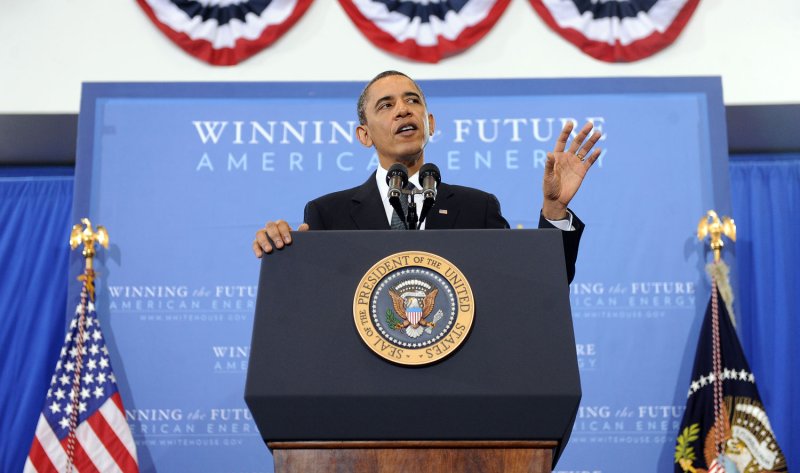U.S. President Barack Obama lays out an energy policy during a speech at Georgetown University in Washington on March 30, 2011. Obama said he wants the U.S. to reduce oil imports by a third in the next 10 years. UPI/Roger L. Wollenberg |
License Photo
COLLEGE PARK, Md., March 31 (UPI) -- Friday, economists expect the U.S. Labor Department will report the economy added 200,000 jobs in March. After adding 192,000 jobs in February, this would indicate the economy is gaining some flying speed. But if the jobs figure falls significantly short of 200,000, the economic recovery is in a lot of trouble.
Since July 2009, U.S. gross domestic product has been growing at a bit less than 3 percent a year -- just enough to keep pace with productivity growth at 2 percent and population growth at about 1 percent.
After adding less than 100,000 jobs per month the 13 months ending in January, the private sector is starting to create jobs in significant numbers that aren't temporary or in the government subsidized healthcare and social services sector.
If the March jobs figure comes in at less than 165,000, that would indicate the higher oil prices and political conditions in Africa and the Middle East, renewed weakness in the housing market, uncertainty about the federal deficit and sovereign debt crises in Europe, and supply chain disruptions from the Japanese crisis are slowing growth to 2.5 percent, perhaps less.
Growth in the range of 2.5 percent is hardly sustainable -- any hiccup would cause a negative cycle of renewed layoffs, consumer pessimism, falling retail sales, more layoffs and, ultimately, recession.
Weekly jobless claims seem to be stabilizing at around 390,000. While that is better than in 2010, it is hardly a healthy level for an expanding economy -- something less than 350,000.
If the economy created fewer than 165,000 jobs in March, it is at peril of a second recession.
Much stronger growth is needed to get unemployment down to an acceptable level. The economy must add 13 million private sector jobs over the next three years -- 360,000 each month -- to bring unemployment down to 6 percent. Core private sector jobs must increase at least 300,000 a month to accomplish that goal.
Growth in the range of 4 to 5 percent is needed and possible to get unemployment down to 6 percent over the next several years but significant structural barriers remain.
At 3.3 percent of GDP, the $500 billion trade deficit is a drag on domestic demand and taxes U.S. growth. Oil and trade with China account for nearly the entire U.S. trade deficit.
President Barack Obama's announcement on energy policy adds little new. He is banking on electric cars and alternative technologies, such as wind and solar, to replace imported oil but those won't pull down gasoline consumption enough to significantly reduce the oil import bill for a least a decade.
Failure to produce more domestic oil and gas, by sending dollars abroad that don't sufficiently return to purchase U.S. exports, is a jobs killer and the administration remains unrelenting on its excessive regulatory crackdown on offshore drilling.
China maintains an undervalued currency by spending 10 percent of GDP to purchase dollars -- this reduces domestic Chinese consumption and subsidizes Chinese exports by about 35 percent. Failure to act to offset Chinese currency subsidies, for example by taxing dollar yuan conversions, is the single most significant flaw in administration policy to create an adequate numbers of jobs.
More broadly, major trading partners in Europe and Asia rely on value added taxes to finance government and healthcare, whereas Americans pay higher corporate taxes and directly for healthcare.
Under WTO rules, VATs are rebateable on exports from Europe and Asia and are applied on imports from the United States into those markets, creating huge pricing disadvantages -- American products are essentially taxed twice. A neutral change in U.S. tax policy toward a VAT -- swapping a VAT for reductions in corporate and personal income taxes -- would help remove a major competitive disadvantage on U.S. exporting and import-competing industries.
Finally, the 2010 healthcare law is pushing up healthcare costs rather than reducing those as promised, making insurance unaffordable for many small and medium-sized businesses. Although manufacturing has enjoyed a stronger recovery than the rest of the economy, it has been significantly focused on activities that use very little labor illustrating the burden that healthcare imposes on U.S. employers.
Without fixing energy policies, addressing Chinese currency subsidies, modifying the tax structure and truly reforming healthcare, high unemployment will be a permanent feature on the U.S. economy and real wages will decline. Neither the Obama administration nor Republican leadership in the Congress appears inclined to do what needs to be done.
--
(Peter Morici is a professor at the Smith School of Business, University of Maryland School, and former chief economist at the U.S. International Trade Commission.)
--
(United Press International's "Outside View" commentaries are written by outside contributors who specialize in a variety of important issues. The views expressed do not necessarily reflect those of United Press International. In the interests of creating an open forum, original submissions are invited.)















